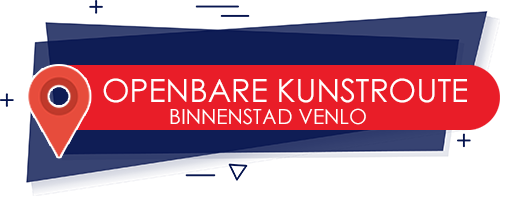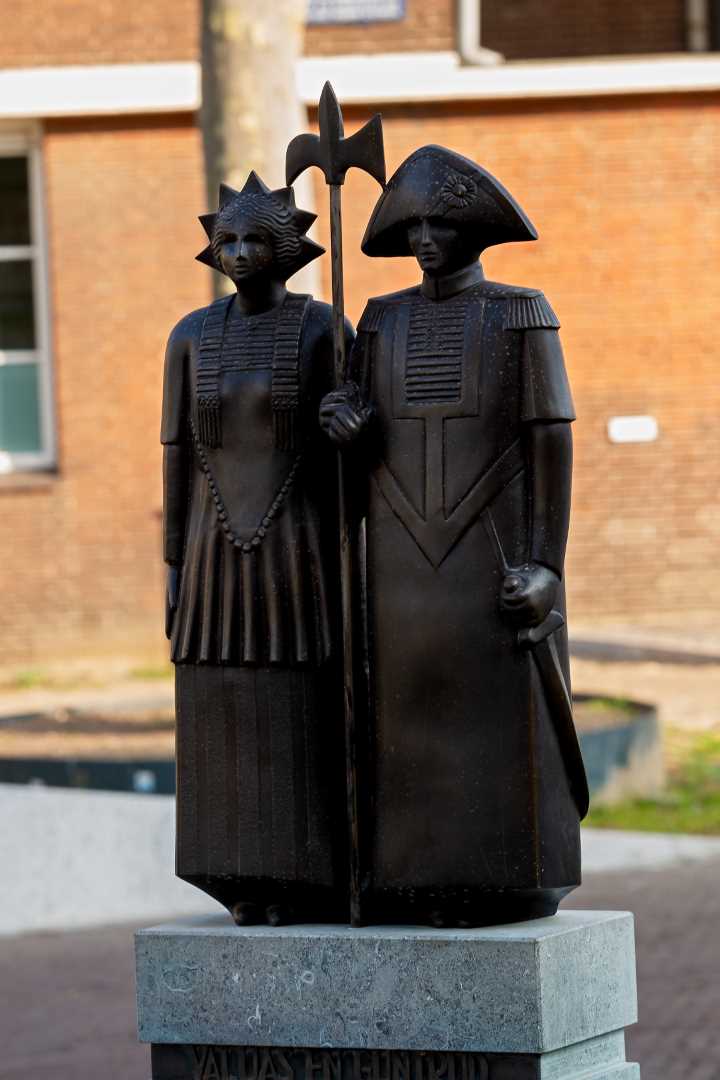Valuas and Guntrud
Keulsepoort
Valuas and Guntrud – Hay Mansvelders
The legend says that Valuas (Flujas in the Venlo dialect) and his wife Guntrud were the founders of Venlo. Valuas was the chief of a tribe called the Bructers. Allegedly, they have settled in 96 AD on the banks of the river Maas in and around a castle called Vrijburg.
The two of them as founders of the city goes back for centuries. Already in the Middle Ages, they were immortalised in the form of the giant puppets that still occasionally travel through Venlo with the Akkermansgilde. This bronze sculpture was made by Hay Mansvelders in 2000 and donated to the city by Frans Swaghoven of hotel-restaurant Valuas. As part of the project, Mansvelders also made a small version of the sculpture, which was cast in bronze. Only 250 pieces were made at that time. To meet the ever-present demand for the miniature version, the Venlo artist decided to revive the smaller version in 2020, albeit with some minor adjustments.
The artist: Hay Mansvelders
Hay Mansvelders (Venlo, 1935) is a self-taught artist. At a young age, he started working at the Beeldenfabriek St. Joseph, a manufacturer of religious sculptures. He became proficient in the craft and developed an extensive knowledge of classical imagery and its symbolism. He also took private lessons for several years from Limburg artists such as Sef Moonen and René Wong.
In the 1960s, Mansvelders was co-founder of the Venlo Free Academy, a centre for artistic training; as a (staff) teacher he focused mainly on the artistic development of young people. It was his main drive to show young people the beautiful side of cultural self-expression.
“Culture has the abbilitiy to change people”, according to Mandvelders. And he still has that view: art should be available to everyone, no exceptions. After all, it was his own experience that creative expression leads to building up self-confidence.
In the 1980s, Mansvelders became director of the North Limburg Free Academy. When he had to spend more time in an office and meeting structure and had less and less time for his own work, he established himself as a ‘visual designer’, a name he came up with himself and which he has kept ever since. He did not see himself as an artist, ‘out of respect for the real thing’, he regularly stated.
Various of his sculptures can still be found in public spaces in his home town Venlo, such as Valuas and Guntrud, the founders of Venlo, near the Limburgs Museum and the Jocushaan near the town hall. The basis for Hays’s artistry is and remains his fascination for everything that grows and blooms; animals, plants and people. He developed his own visual language, recognisable by the balanced line between figuration and abstraction.
De Keulsepoort (The Keulse Gate)
As one of the four main gates, the Keulsepoort was part of the fortifications of the city of Venlo (built between 1340 and 1345). In the 19th century, these fortifications – like those of many other Dutch cities – became so constricted that it was decided to demolish them. That happened between 1867 and 1872. Work at the site in 2011 revealed that the foundations of the gate are still intact underground.
After the city walls were demolished, the Köln-Mindener railway line was built at Cologne Gate and what is now the (adjacent) Juliana Park. This was a German railway line that was part of the Hamburg-Paris route. Just before the Second World War, near the foundations of the Keulsepoort, the building was constructed that served as a post office for a very long time, but nowadays houses the Van Bommel van Dam Museum.
The railway track disappeared after the war and was replaced by Julianapark. After that, the Keulsepoort was one of the access roads for car traffic to the inner city for several decades.
That road was closed off at the end of the last century, after which the Keulsepoort became a square. In 2000, the Limburgs Museum was built on that square, and in 2021, the Van Bommel van Dam Museum opened its doors in the adjacent, former post office, after having been located on the Deken van Oppensingel, a few hundred metres away, for about fifty years.
That building was specially built for the museum and also housed the two founders, Maarten and Reina van Bommel-van Dam. In 2021, a start was also made on the redevelopment of the Keulsepoort, which has been given a greener character, among other things. Because of the presence of the two museums, the Keulsepoort is often called Museumplein in popular speech. Opposite the Limburgs Museum is a building that was originally one of the oldest and perhaps the oldest petrol stations in the Netherlands. It dates from 1933 and belonged to the American Petroleum Company (later Esso). Nowadays, one can eat some ice cream there.

